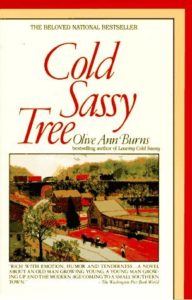In its most basic meaning, setting in fiction refers to the time and place in which the action of a novel or short story occurs. In some works the setting isn’t much more than a few simple references to time and place in order to ground the work in reality. In other instances setting takes on more importance and plays a major role in how the work affects the reader.
For ease of explanation I’ve labeled some ways in which setting functions in the following fictional works. You may come up with other labels that you prefer. But whatever terminology you use, the important aspect to remember is to notice how the setting contributes to the novel or story’s meaning.
Setting as Character
Lillian Boxfish Takes a Walk by Kathleen Rooney
St. Martin’s Press, 2017
 In some novels the setting is so integral to the story’s effectiveness that it becomes a character in its own right. In this book 85-year-old Lillian Boxfish walks all over Manhattan on New Year’s Eve, 1984. Lillian worked in the advertising department of R.H. Macy’s department store and ascended to the top of this emerging profession. She was also a published poet with a modest amount of fame. As she walks all over her beloved Manhattan, she remembers both her own life experiences and the city in which they occurred. By the time she arrives back home, she has narrated not only her life story but also a tribute to the city that never sleeps in all its historic grandeur.
In some novels the setting is so integral to the story’s effectiveness that it becomes a character in its own right. In this book 85-year-old Lillian Boxfish walks all over Manhattan on New Year’s Eve, 1984. Lillian worked in the advertising department of R.H. Macy’s department store and ascended to the top of this emerging profession. She was also a published poet with a modest amount of fame. As she walks all over her beloved Manhattan, she remembers both her own life experiences and the city in which they occurred. By the time she arrives back home, she has narrated not only her life story but also a tribute to the city that never sleeps in all its historic grandeur.
See also The Best Books Based in Every State:
The setting is so deeply entwined with these texts, the story couldn’t even exist in another place or time.
Setting as Atmosphere
Chance by Kem Nunn
Scribner, 2014
 This novel is set in San Francisco—but not the charming city by the Bay with its quaint cable cars and magnificent vistas. No, in this city, soon-to-be-divorced Dr. Eldon Chance lives a life “wherein each day seemed at risk of being even more dimly lit than the one before it” (p. 7). A recent fire in the East Bay hills has left the area covered in ash: “Cars were made to appear uniform in color. It lay thick in the corners of things like drifts of dirty snow” (p. 9).
This novel is set in San Francisco—but not the charming city by the Bay with its quaint cable cars and magnificent vistas. No, in this city, soon-to-be-divorced Dr. Eldon Chance lives a life “wherein each day seemed at risk of being even more dimly lit than the one before it” (p. 7). A recent fire in the East Bay hills has left the area covered in ash: “Cars were made to appear uniform in color. It lay thick in the corners of things like drifts of dirty snow” (p. 9).
Much of the novel’s action takes place at night, in a dark world of deceit and criminal activity. This is the San Francisco of fog, mist, and nighttime crime, where thoughts and desires scuttle off down the darkest paths and then emerge from the depths to bite us. By inverting the typical postcard image of San Francisco, Nunn underscores the dark bleakness of the life Eldon Chance chooses to live.
Setting as Metaphor
“The Fall of the House of Usher” by Edgar Allan Poe
1839
In this gothic masterpiece an unnamed first-person narrator approaches the decaying family mansion of his childhood friend Roderick Usher. The narrator has been summoned there by a letter from Roderick, whom he has not seen for many years, to help allay a mental malady.
The narrator reads with Roderick in an attempt to lighten Roderick’s gloom. The body of Roderick’s twin sister has been placed in the family vault, but Roderick believes she is still alive. When the sister appears before Roderick and the narrator in her bloodstained shroud, brother and sister fall dead together.
The narrator quickly leaves. As he rides away on his horse, he turns for a final look at the family mansion:
The radiance was that of the full, setting, and blood-red moon, which now shone vividly through that once barely discernible fissure, of which I have spoken as extending from the roof of the building, in a zigzag direction, to the base. While I gazed, this fissure rapidly widened—there came a fierce breath of the whirlwind—the entire orb of the satellite burst at once upon my sight—my brain reeled as I saw the mighty walls rushing asunder—there was a long tumultuous shouting sound like the voice of a thousand waters—and the deep and dank tarn at my feel closed sullenly and silently over the fragments of the “House of Usher.”
In his comprehensive analysis of Poe’s works, Poe Poe Poe Poe Poe Poe Poe (Doubleday, 1972), Daniel Hoffman calls the House of Usher (not the story, but the building) “no house at all but a profound and intricate metaphor of the self” (p. 302). Hoffman describes the story as a compendium “of nearly all of Poe’s obsessional motifs, here joined together in a dazzling, garish, and intricately consistent pattern of concentric meanings” (p. 303).
However, one need not examine all of Poe’s writing to understand the point of this story, in which the house is a metaphor of dark family secrets and signifies the disintegration of the individuals who live there as well as of the family line and its dwelling.
The personification of a creepy old mansion or castle is a common characteristic of gothic novels such as Rebecca by Daphne du Maurier and We Have Always Lived in the Castle by Shirley Jackson.
Setting as Plot Necessity
My Cousin Rachel by Daphne du Maurier
1951
Philip Ashley, age 24, narrates this first-person story of obsession. Philip was raised from early childhood by his older cousin, Ambrose, as heir to the Ashley estate. After Ambrose travels to Italy to check on some property, Philip receives a letter from Ambrose telling of his marriage to a woman named Rachel. As communication from Ambrose becomes less frequent and more mysterious, Philip decides that he must go to Italy to check on Ambrose himself.
Philip has lived his entire life on the Ashley estate, near a small village on the isolated coast of Cornwall in England. His experience of the world outside his home has been limited, and this novel amounts to his own telling of his coming-of-age story. Philip’s isolated living situation is a necessary part of the setting because his naiveté is central to the story.
The time of the setting is just as important as the location. Nowhere does the novel specify a year, but as Philip weighs the decision of whether to travel to Italy to check up on Ambrose, he notes that going himself will be more expedient than sending a letter. Although the trip to Italy by ship will take three weeks, sending a letter, which would travel on the same ship, would require three weeks plus another three weeks for a reply to arrive back in Cornwall. This setting before the arrival of any type of quick communication is crucial to the story because in Italy Philip learns a bit about Rachel, even though he doesn’t meet her. This information about Rachel feeds his speculation about her and her possible motivation for marrying Ambrose.
To say any more would spoil the pleasure of reading this novel. I love a good first-person narrator, and Daphne du Maurier is one of the best writers at creating such a character. Philip’s story requires the isolating setting of both time and place that contributes to his initiation into adulthood.
Setting as Historical Representation
Cold Sassy Tree by Olive Ann Burns
Dell, 1984; rpt. 1994
 The best historical fiction aims to recreate the feel of both the time and place in which the action occurs. In works of historical fiction, setting takes center stage to communicate not only the physical artifacts but also the social and cultural milieu in which the characters live their stories.
The best historical fiction aims to recreate the feel of both the time and place in which the action occurs. In works of historical fiction, setting takes center stage to communicate not only the physical artifacts but also the social and cultural milieu in which the characters live their stories.
In Cold Sassy Tree, Olive Ann Burns recreates life in a small town in rural Georgia at the beginning of the twentieth century. The main character is Will Tweedy, age 14, grandson of E. Rucker Blakeslee, proprietor of the town’s general store. As the novel opens, Grandfather Blakeslee, whose wife died only three weeks earlier, shocks the townsfolk by marrying one of his employees, Miss Love Simpson. His failure to live out the expected year of mourning offends his neighbors and shames his family. Furthermore, Miss Simpson is only half his age and—heaven forbid!—a Yankee.
In claiming the right to live his life as he sees fit, Grandfather Blakeslee becomes a spokesperson for the social changes beginning to chip away at the density of long-held Southern traditions in 1906. A concrete representation of the same phenomenon is the arrival of the automobile, which is about to expand the town’s world and drive it out of the old isolated world of the Confederacy into modern times. Cold Sassy Tree is a coming-of-age novel in which young Will Tweedy enters adulthood just as his hometown grows into the expanding world of a new century.
Setting in Speculative Fiction
The Harry Potter series by J.K. Rowling
 The term speculative fiction encompasses fantasy and science fiction, works of literature that take place in an imagined world. In a process called world building, authors of speculative fiction create a world whose setting contributes to the work’s meaning. As in historical fiction, setting takes center stage in speculative fiction.
The term speculative fiction encompasses fantasy and science fiction, works of literature that take place in an imagined world. In a process called world building, authors of speculative fiction create a world whose setting contributes to the work’s meaning. As in historical fiction, setting takes center stage in speculative fiction.
J.K. Rowling’s Harry Potter series is a good example of how setting functions in speculative fiction. In these works the author must build a complete world and communicate the details of that world to the reader as necessary throughout the book (or series). Before writing the series Rowling had created a complete and detailed outline of how the wizarding world worked, but if she had started out by explaining that world, she never would have gotten around to the story at the novels’ heart—and readers wouldn’t have kept reading. Rowling skillfully develops the reader’s understanding of the world at Hogwart’s by incorporating details as the story progresses, giving us tidbits as we need them to understand the significance of the characters’ actions and decisions.
It would be fair to say that Harry Potter’s world is so crucial to the series that the setting becomes a character in its own right, as it does in Lillian Boxfish Takes a Walk. However, both of these examples illustrate how setting exists not just for its own sake, but rather in service to the human story at the novel’s center.
© 2017 by Mary Daniels Brown

